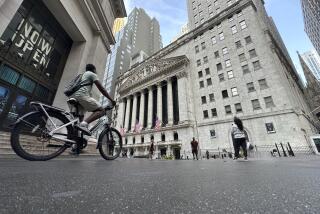Greenspan Signals Stable Rates Amid Uncertainty Over Asia
WASHINGTON — Federal Reserve Board Chairman Alan Greenspan signaled Tuesday that the Fed would probably hold interest rates steady for several more months--at least until it becomes more certain about the Asian economic slump’s impact on the U.S. economy.
In congressional testimony, Greenspan said that while the recession in Asia seems likely to help ease inflation pressures at home, the outlook is still uncertain enough that the Federal Reserve might risk trouble if it moves too quickly to cut or raise rates.
The cautious assessment rattled financial markets, which had been hoping that the central bank would cut interest rates this spring in recognition of slower-than-expected inflation.
The Dow Jones industrial average fell 40.10 points on the day to close at 8,370.10. The yield on the bellwether 30-year Treasury bond rose to 5.95%, up from 5.90% on Monday to its highest level since Jan. 23.
Meanwhile, the Labor Department reported that consumer prices remained unchanged in January for the first time in four years, and a widely watched measure of consumer confidence rose to a 30-year high.
Janet L. Yellen, chairman of President Clinton’s Council of Economic Advisors, told news media at the White House that the reports show that the economy is “still going strong” and is likely to continue robust--with low inflation--even with the slump in Asia.
Greenspan also hailed the economy’s performance as “exemplary,” conceding that inflation pressures had turned out to be less intense than some policymakers had feared, particularly in the face of continuing momentum in the economy and a rapidly intensifying labor shortage.
He said that the key question now is whether the drag imposed by Asia will be enough to keep U.S. inflation pressures in check or whether inflation will heat up anyway--possibly forcing the Fed to nudge interest rates up.
At the same time, Greenspan said, there is the possibility that the Asian crisis will weigh more heavily on the U.S. economy than expected--a situation that could prompt the Fed to cut rates to help keep the seven-year economic recovery going strong.
The wait-and-see posture essentially reaffirmed the strategy that Greenspan outlined in similar testimony last month. On Feb. 5, the Fed’s policymaking Federal Open Market Committee, citing uncertainty over the weakness in Asia, voted to leave interest rates unchanged.
The chairman has been facing increasing pressure to lower short-term interest rates on the grounds that inflation has proven to be less of a threat than policymakers feared. Some have argued that holding rates steady for so long amounts to a tightening of monetary policy.
Indeed, several members of the House banking and financial services subcommittee who heard Greenspan’s testimony pointedly urged him to push rates down. Panel Chairman Michael N. Castle (R-Del.) argued that the move is needed “to help American families keep more of what they earn.”
Greenspan, however, declined to commit the Fed to any course of action, saying that officials want to wait until they are more certain of the impact the Asian slump will have.
Greenspan’s remarks were characterized as measured by private analysts.
David M. Jones, chief economist at Aubrey G. Lanston & Co. in New York, said the Fed chairman went “out of his way to strike a balance between the threats facing the economy. He implied strongly that he will be keeping policy unchanged for some time to come.”
Robert G. Dederick, economist for Northern Trust Co. in Chicago, agreed. “It leaves [Fed policymakers] still watching and waiting to see what develops. That’s what they’ve been doing and that’s what they’re going to continue to do.”
* NO INFLATION: Consumer prices were unchanged in January. D3
(BEGIN TEXT OF INFOBOX / INFOGRAPHIC)
End of Bond Rally?
After diving in mid-January, Treasury bond yields have rebounded amid doubts that the Fedwill ease credit soon.
30-year T-bond
Feb. 24: 5.95%
*
5-year T-note
Feb. 24: 5.63%
*
3-mo. T-bill
Feb. 24: 5.32%
Source: Bloomberg News
More to Read
Get the L.A. Times Politics newsletter
Deeply reported insights into legislation, politics and policy from Sacramento, Washington and beyond. In your inbox three times per week.
You may occasionally receive promotional content from the Los Angeles Times.









